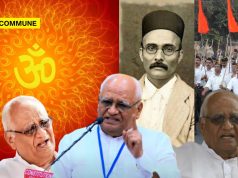
Western countries got benefitted by the first two industrial revolutions. India could not avail such benefits, due to the colonial rule. However, since 15 August 1947, India has traveled a long way to ensure her security in vital areas like food, health, education, environment, energy, trade, economy etc in addition to protecting her borders in the land, air and sea. Many leaders, intellectuals, technologists, scientists, academicians, administrators, doctors along with millions of farmers, technicians and soldiers have contributed for this from the areas of agriculture, education, health care, industry and defense. While these areas have grown after independence in the self-ruled India, a new program conceived and developed in independent India as late as late 60s has helped to leapfrog almost all the above areas and has also taken India as one of the leading nation in the world in one field , it is Indian Space program.
The world witnessed the first man made satellite Sputnik-1 orbiting the earth in 1957 and the first man Yuri Gagrin enter space and return in 1959. It kicked off the space race between USSR and USA. For India it was very modest beginning, setting up a launch facility in a church in the Kovalam beach near Thiruvananthapuram in 1962 and the first launch of sounding rocket on 21 November 1963. Indian Space Research organization (ISRO) was formed on 15 Aug 1969, twenty two years after independence.
ISRO took very caustious baby steps to master technological skills to make satellites, launch vehicles and tailoring her space program for India specific societal applications. In that process, ISRO acquired range of launch vehicles namely SLV-3 , ASLV, PSLV , GSLV and GSLV M-2,3 capable of launching 40kgs of satellite in 400 km around the earth to few tons around the Moon and Mars. PSLV, the work horse of ISRO has shown it’s agility in placing large number of satellites in one go that too in different orbits. Globally PSLV is leading in that segment of launch vehicles having launched more than 350 satellites from 34 countries.
In the area of satellites, ranging from the modest first satellite Aryabhatta to one of the biggest constellation of the state of the art communication satellites, radar satellites, highly agile remote sensing satellites, constellation of regional navigation satellites (NAVIC), meteorological satellites, ISRO has placed all the type of satellites in the orbit. These satellites serve the needs of emerging India in the areas of radio, TV broadcast, telephony, mobile communication, telemedicine, tele education, digital governance, weather monitoring, early warning, disaster management, banking and many more.
ISRO’s regional remote sensing centers combine the services of remote sensing, meteorological, and communication satellites to give vital inputs to the farmers, fishermen and policy makers. Indian defense personnel from Army, Navy and Air Force also get required support from India’s space assets. Indian railways and airlines get support from the services of navigation and communication. Likewise, many India specific applications are being served using the constellation of more than sixty Indian made satellite assets.
As India is the land of Aryabhata and Bhaskara, Indian space program contributes to unravel the mysteries of space. Science satellites like multi wave length astonomy satellite Astrosat, and planetary missions like Chandrayaan-1, Chandrayaan-2, and Mars Orbiter Mission (MOM) played major roles in the world of space science.
Discovery of water molecules in the tenuous atmosphere, surface and subsurface of the moon by Chandrayaan -1 is a contribution by ISRO in understanding moon better. The way ISRO conceived and executed the Chandrayaan-1 mission led to the noteworthy discoveries. It made the whole world to look back the Moon with renewed interest. Now some serious efforts are being taken up to setup human colony in the moon by a team of space fairing nations and India could play a meaningful role in it.
India also has taken up manned space mission, GAGANYAAN and a mission to explore the Sun through Aditya.
ISRO has grown leaps and bounds over the last 63 years of journey. While doing so, Indian academia and industry also were guided and nurtured by ISRO in a well thought out manner to take the mantles in this niche area.
Boyed by the all round developments happened indigenously in the area of space and space applications as spearheaded by ISRO, recently Government of India has made a major space policy revision. Now private industry can take major part of realizing space assets in terms of launch vehicles, satellites and applications both for national and international needs. New authorities namely INSPACE and NSIL have been formed to guide the Indian industries. ISRO will primarily concentrate on space research and space technology upgradations and innovations.
Actions being initiated for state of the art launch pad near Kulasekarapattnam at the southern part of India. Possibly new end to end infrastructures also could be built for small satellite and launch vehicles by the Indian private industry. Considering few hundred satellites are being launched in the recent past by many satellite operators, with the said emerging developments in India, we could provide a very competitive opportunity for the international players in the field of space to look at India in commercial terms.
While we salute the freedom fighters on this auspicious day, one also need to remember the founding fathers and contributors to the Indian space program. The list is so big, not limited to the luminaries like Vikram Sarabhai, Satish Dawan, UR Rao, Abdul Kalam, Kasturirangan, Madhavan Nair, Radha Krishnan, Kirankumar, Sivan and Somanath.
When India celebrates her 75th independence day, every Indian house and office premise will be hoisting the tri-color national flag. I am feeling elated and proud for being part of Chandrayaan-1 project team that planted the tricolor flag near south pole of the Moon in 2008, placing India to be the first country to do such a feat in the polar region of the Moon, which is like the Himalayas of the Earth.
Very soon, India’s own astronauts will enter space in our own rockets. In the years to come, India will achieve several other milestones adorning itself with accolades.
As we enter the Amritkaal, ISRO is gearing up to take mankind to the future!
Click here to subscribe to The Commune on Telegram and get the best stories of the day delivered to you personally




